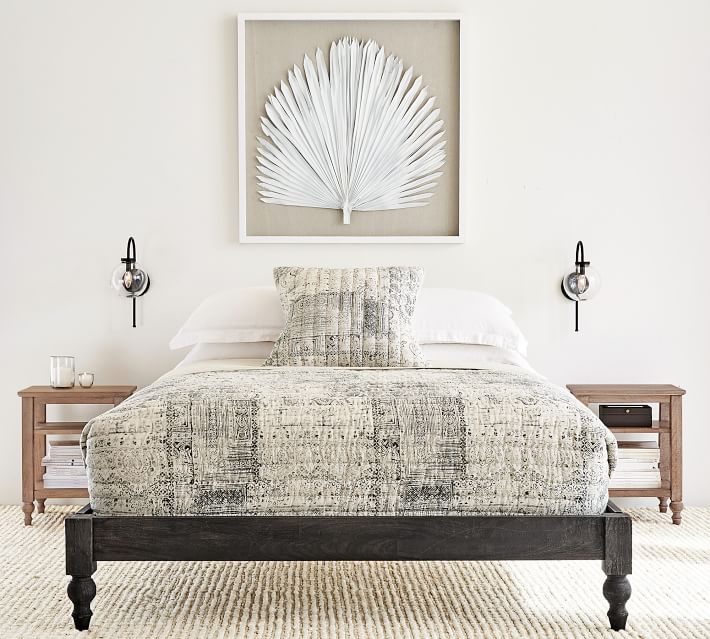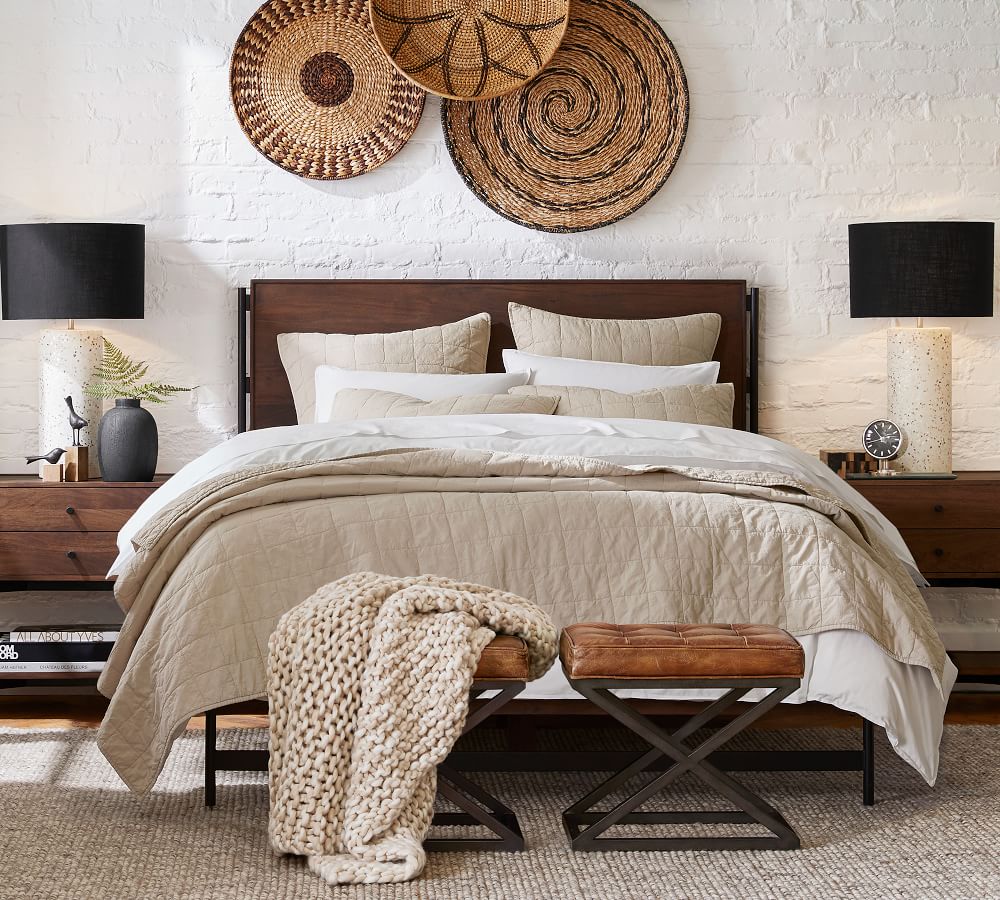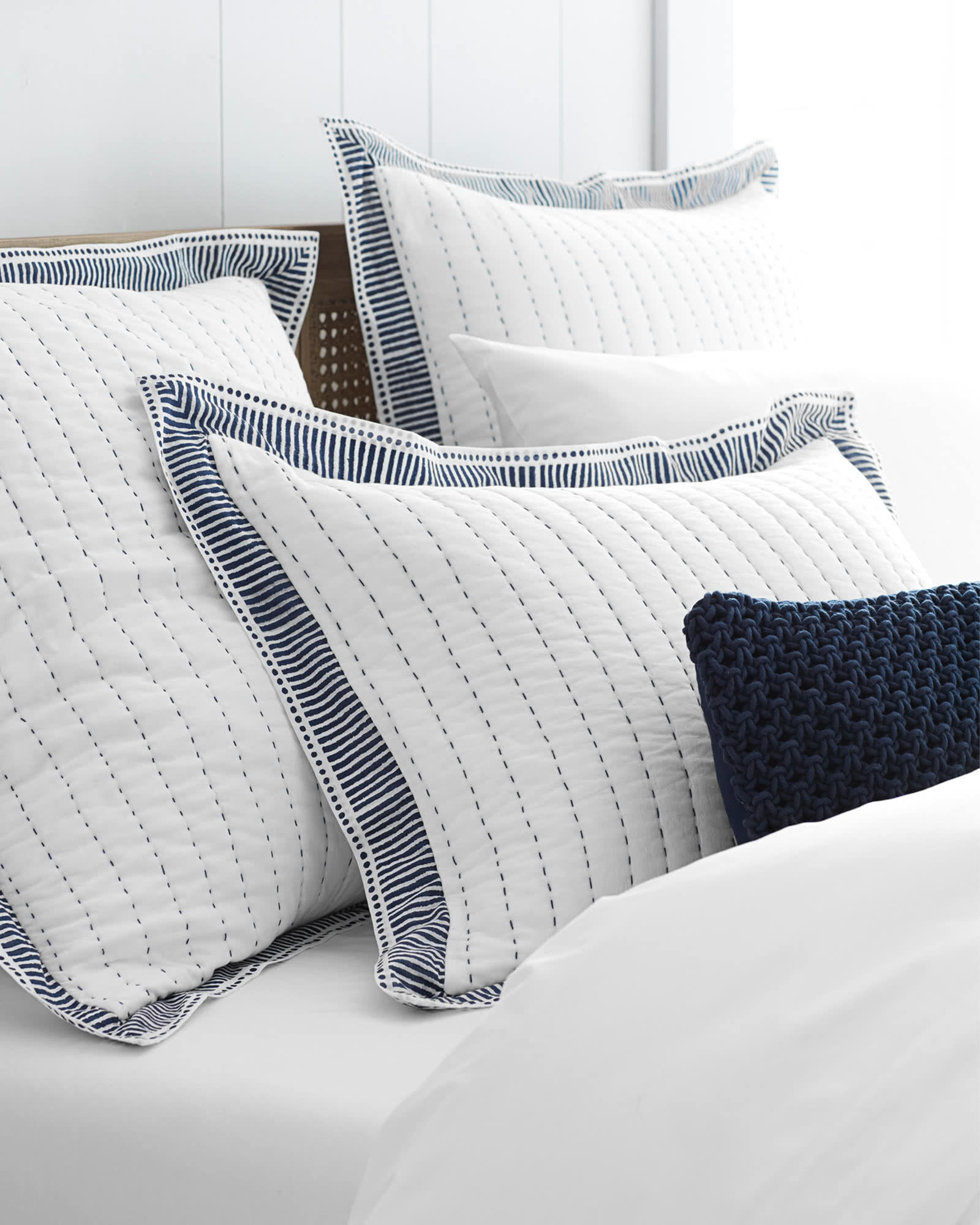A Perfect Bed: The Basics of Bedding

Let us start by saying that bedding is super personal! Everybody has their own unique and specific preferences surrounding what they want from their sleep experience. Maybe you love an extra warm and cozy bed, or if you’re hot all the time, you probably like lightweight, soft sheets, while others want super crisp sheets.
The thing you need to understand, however, is that bedding is about so much more than just the sheets. A well-made bed actually starts on the floor. It should not only look fabulous but provide good sleep for you personally, and to get that; you need to start with what you are sleeping on…
Support

Maybe you have a platform bed, a formal four-poster, or perhaps a daybed. There are so many types of beds, but they all need this important basic: cushioning. Whether it’s a mattress or a mattress and box spring set, the support of the mattress is key. 🗝️
PRO TIP: If your bed frame is built so that the side of the box spring is visible, you need to accommodate that in your finished bedding choices. For example, you can use a bed skirt or an enclosed upholstered frame. Another option is to do a fitted sheet of the same material as either the sheets themselves or something complementary to the top layers of the bedding.
Know Your Mattress

Mattress Size
Know your mattress size! The difference between a regular King and a California King may only be 6 inches, but that’s significant. European mattresses also have their own unique sizing. Whether you have a teeny tiny single (by the way, if it’s a single, why is it called a twin? 😆) or a mattress the size of a parking lot, you need to know its dimensions to be able to make your other bedding choices.
Standard Mattress Dimensions (US)
- Twin: 38” x 75” | 96.5 X 190.5cm
- Twin XL: 38” x 80” | 96.5 X 203cm
- Full: 53” x 75” | 134.5 X 190.5cm
- Queen: 60” x 80” | 152.5 X 203cm
- King: 76” x 80” | 193 X 203cm
- California King: 72” x 84” | 183 X 213cm
Mattress Material
Do you have a regular 8-inch high mattress or one of the newer state-of-the-art foam designs? Let’s say your mattress is a firm regular box spring, but you like it cushy- then that needs to be addressed in the bedding department.
Let us explain…
Covers/Pads

You always need a mattress cover, and it’s a good idea to get two types if this is your primary bed. We always recommend that people start with a hypoallergenic mattress cover. This is where it’s essential for you to know your mattress size because it needs to fit snugly; you don’t want it moving around on the bed.
Just like you pay attention to the thread count of sheeting- you also want to pay attention to what the mattress cover is made of. High thread count makes the mattress cover feel crisper and firmer. The lower thread counts will feel less firm and tight. And don’t freak out because we are going to talk about the major misinformation around thread count!
Mattress pads are a big comfort quotient that you want to consider. They come in different thicknesses; for example, let’s say you have a firm mattress, but you really want something a bit softer- in this case, you need an extra dense mattress pad. The thicker and fluffier they are, the softer the cushioning. And yes, they wear out; they only have a life cycle of maybe five years if this is your primary bed.
What is my bed composition?

Maybe you have a platform, bunk beds, a sleigh bed, or a bed with a detached headboard and a metal frame. You want to choose a bed frame that suits both your lifestyle and your style statement. For example, platform beds are great for younger people as they are less expensive, and you don’t need to buy box springs. They are also a little lower, so they are easier to get into. If you’re older, it will need to be raised higher so you can get in and out more easily.
Also, consider your lifestyle and style statement with your decorative bedding choices. For example, if you have a super busy lifestyle, you don’t want to create an extremely intricate bed! If you make your bed every day like your mom taught you, and it takes 10 minutes, you’re wasting precious time! Eventually, you’ll give up on that charade, so keep it simple.
Time to move up to the next layer…
Sheets

Sheets are super complicated, so for now, let’s talk basics. Sheets come in a couple of different fibers (polyester, cotton, Egyptian/Supima cotton, linen, silk, bamboo), and you want to know the fiber content. The other thing about sheeting is that you want the colorations and/or patterns to align with your style statement.
There are two ways to sheet a bed: there are a pair of sheets, which is a standard fitted sheet with the elastic that goes over the mattress itself, and then there’s the flat sheet, which is the sheet that goes on top of it. There’s also what’s called the hospitality bed, which is simply three flat sheets, one tucked into the mattress on all sides, the next flat sheet lying on top, and an additional sheet layer on top that acts as your first blanket or temp control covering.
SUPER PRO TIP: Hotel laundries do a hot head pressing, making the sheets super smooth and yummy. If you want a hotel bed- do the three-sheet trick and have your sheets done at a laundry that does fluff and folds with a hot head presser.
Top Cover

From duvets to blankets and comforters- these tend to be more decorative than the sheeting, but often, it’s best to keep it simple- it all just needs to speak to your style statement. Be mindful that the top covering is a significant visual element in any bedroom, so the more ornate it is, the more your eye will use it as a focal point. If that’s what you want, great; if not, keep the patterning and/or contrast quieter. You want it to have the appropriate visual style and impact you’re going for in the room.
One of my favorite beds in white Supima cotton linen, with a natural linen duvet cover. Divine! By the way- we are not a fan of polyester quilted bedspreads, as they tend to look like a generic set, and no one wants to sleep under that material. Think bed in a bag- it’s not your highest and best choice, honestly.
Pillows

You need adequate pillows, and to us, the right amount of pillows for two people in a bed is four! Pillows are very personal, so do what works for you! Totally your call when it comes to the choices of thinness, thickness, hypoallergenic, down, down alternative, foam, etc. You have to get a feeling for what you like best because everyone is completely different.
With four pillows, you have the opportunity to do two pillows in your sheet materials and two sleeping-sized pillows in a decorative sham, which can match the duvet or be a decorative version of the sheeting fabric. Either way, you want those to act as decorative buffers.
Now, if you’re a big pillow hound- go for 6! But that’s the max- honestly, you probably don’t need more. Your choice for the finish is either a single fun accent pillow like a bolster or a round pillow; again, it really depends upon your style statement.
Headboard

Beds look unfinished without some type of material change where the bed meets the wall. If you just have your bed pushed up against the wall- it seems like you just moved in!
There are many ways to distinguish the head of the bed from the surface it’s up against, everything from painting a square on the wall to a stretched fabric. It’s vital that you have something that creates a visual distinction.
A headboard is also useful for long-term maintenance of whatever the wall finish is.
Footboard

The footboard or footband can be a second folding blanket or a throw. Another option is to do a fabric band- it works especially well in a traditional home for a formal look. Remember that whatever you add should not compete with the rest of the style statement.
Remember- the smaller the bed- the less you need! It’s usually best to keep things simple. If your bed can’t handle the extra items visually, you can always place them in baskets on the side of your bed. 🧺
Who’s ready for a nap? Not quite yet? Perfect, because we’ve got more dreamy design info! Check out Small Bedrooms: How to Create a Sleep Sanctuary in 6 Simple Steps!
Do you need help figuring out which style statement is right for you? Our Style Vibe Quiz is seriously legit! Don’t miss it!
Already know which design style speaks your language? Cool 😉 Let’s pop over to The Store and check out all the delicious decor goodies we handpicked just for you!
4 thoughts on this post
Leave a Reply
You must be logged in to post a comment.



Would linen pillow cases work with cotton sheets? Is it OK to mix it up?
I’m thinking of doing a bed makeover – any favorite sheet brands y’all?
Great tips, @LisaHolt! Should the bed be the focal point in a master bedroom?
What would be the solution to this bed. The window far to the right and the bed is placed in the middle of that wall. There is no other place to put the bed. Should I extend the drapes to the left to center the bed? We never open these drapes, wondering if we should just close up this window. There is a same size window facing east (this is facing south). Also after watching some of your videos I may eventually want to pick a lighter color for the drapery. You suggestions would be appreciated. Learning so much from your videos, thanks.